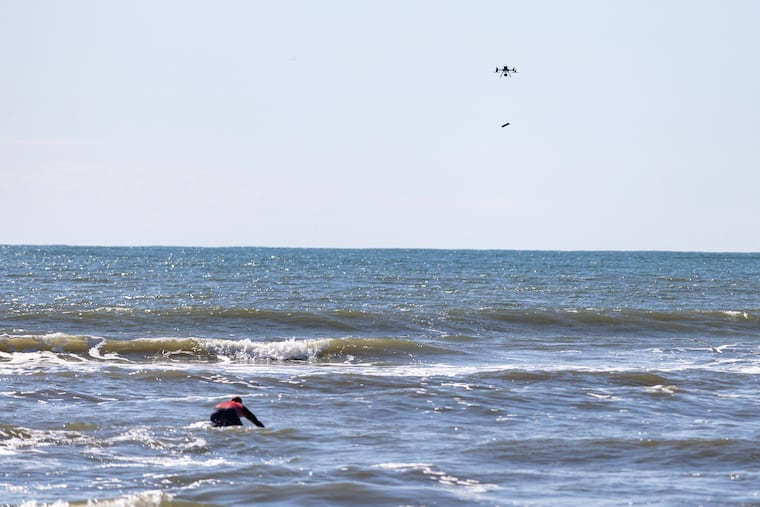These drones will be used by Atlantic City Beach Patrol for rescues, after-hour patrols, and shark spotting
“It can be [a game changer] to bring something out immediately.”

ATLANTIC CITY — As Brendan Santangelo, a lead guard with the Atlantic City Beach Patrol, waited below in the waves Tuesday, a drone hovered above. It was directed by Jamie Allen, the fire department’s lead drone pilot, standing on the beach.
With a push of a button, the drone released its cargo: a flotation device that automatically inflates when it hits the water. And there it was, glistening in the sun on the drone controller screen: the long yellow Restube, grabbed by Santangelo, whose role was to portray a distressed swimmer.
He was then scooped up by helmeted lifeguard Louis Parks and taken into shore by personal watercraft, followed by the drone, which also made it safely to shore.
It will be a summer of new technology in Atlantic City, as drones will join seagulls over the beach and ocean. Beach Patrol units will have a fleet of drones to aid in rescues and before- and after-hours patrolling and response, as well as shark and other hazard spotting.
On Tuesday, members of the storied 132-year-old ACBP aided by fire department officials and representatives of National Aerospace Research & Technology Park, based in Egg Harbor Townshipdemonstrated the latest technological advance they say will greatly expedite rescues.
The drones squawked out siren warnings and voiced shark alerts and orders for swimmers to leave the water. The drones will be programmed to be able to issue these warnings in multiple languages, said Fire Chief Scott Evans.
A 24-hour town with lots of riptides
The drones will leverage the coverage currently provided by lifeguards, a fleet of personal watercraft, paddle boards and the iconic fiberglass Van Duyne surf boats, said Evans. He said Atlantic City is also using drones for code enforcement and firefighting.
“The thing about Atlantic City, we’re a 24-hour town,” said Evans. “Our beach patrols are on 10 to 6. A lot of swimmers tend to come out earlier, and they tend to stay a lot later. We can notify swimmers to please stay out of the water. During early-morning recons, the drone can patrol for rip currents.
“Having the ability to have a drone to scan the entire beach, the experienced lifeguards will be able to pick the rip currents out pretty easily and share that information.”
Arcady Shteynberg, owner of the company that manufactures the Restubes, was also on hand Tuesday, demonstrating how the device uses a CO2 canister that causes it to inflate when it hits the water.
He said he is also working with New York Police and Fire Department, U.S. Secret Service, and harbor patrol, plus New Jersey beach patrols in Lower Township and Wildwood Crest. The water goes inside an arming cap, which pushes a pressure plate down to puncture the CO2 canister, which inflates the device.
“It can be [a game changer] to bring something out immediately,” Shteynberg said. “But it will still be at the responsibility of the lifeguards and the rescue crews who are out there to ensure they’re doing their first primary role. This is just a tool to help them.”
Beach Patrol Capt. Michelle Burwell said the drones will be a great help with monitoring A.C.’s complex beach terrain for rip currents, which cause serious problems for swimmers all summer long, especially after hours with inexperienced swimmers.
“We have outfall pipes, pier, jetties, rock piles,” she said. “That causes rip currents to pop up. We have rip currents that push through sand bars. That can cause people that are not strong swimmers to get into trouble.
“We’ll be able to launch the drones in a matter of seconds. before we can deploy the after-hours response team.
Evans said that the drone footage will be monitored at Beach Patrol headquarters on South Carolina Avenue, and that the footage will stay with the beach patrol and the city of Atlantic City, in accordance with general records regulations.
Eventually, Scott said the city anticipates having an app that the public can use to get the same alerts.
The public can say, “I’m going to the Atlantic City beach today, let me open my app, and OK, we’ve got rip currents on Chelsea [Avenue], or Seaside or Victoria; they’d be aware of that.”
He said the drones would not be used to patrol any misbehavior or rule breaking on the beach, but instead be used as a teaching tool.
“You get this aerial view of a rip current, you can teach the young lifeguards. We’re really going to educate our employes.”
Though the surf boats are out-maneuvered by both personal watercraft and drones, they’re not going anywhere. “We’re still going to keep the boats,” he said. “We’re Atlantic City. We’re going to keep the boats.”